Day 14 Wednesday Apr 30
Angkor Wat, Ta Prohm, Banteay Kdei and Royal bath (Srah Srang)
WHEN TO GO?
Angkor Wat colossal temple complex:
SUNRISE AT ANGKOR WAT
We had texted the guy who dropped us from the airport and arranged for a full day tuk tuk for three days at 20 usd per day . We know many people bargain it down to $15 but we did not even make that effort.
Breakfast was included at the apartment we stayed but it was at their sister concern which is 500 metres away and it starts only from 7:00 AM .
We were obviously keen on seeing the famous sunrise behind the Angkorwat Temple reflected in the lake at the entrance . So we had to leave a little before 5:00 AM . As explained earlier we had meant to do a grocery run as soon as we landed and checked in but with the flight delay and the taxi delay we could not do it .
Our apartment guy gave us a packed breakfast of two very tiny thin bread slices, a tiny blob of butter and jam and a tiny banana and orange the previous night . The package was huge and the food was TINY portions! I just packed the sandwiches in a small packet. I had made noodles for the night, with added some spices and salt and butter so I packed those noodles also for our lunch and we had our dates, raisins and cashew nuts.
Our tuk tuk driver came in the morning at 5 AM and we were taken to the place that issues tickets. They took our picture there and put it into the ticket. We should have bought the 7 day ticket but by mistake we bought only the three day ticket. Tickets to the Angkor complex – including Angkor Wat and dozens of surrounding temples – are valid for one day (US$37), three days (US$62) or one week (US$72). Angkor Wat opens at 5am for visitors who want to see the sunrise from this iconic spot.
Note the upper level, known as the Bakan Sanctuary, is only open from 7:30am.
Then our driver drove us to the main complex west entrance by 5.30AM, told us to text him or call him when we were through with that so that he can take us to other places in the complex. We can enter the temple site from the main western entry or the less elegant eastern entry. To catch the sunrise photos we need to enter through the main entrance, taking the main entry is a sight to behold and a grand entrance that introduces the iconic structure fittingly.
We sat by the lake for a while but realised that there were low hanging clouds and we wont get a spectacular sunrise. So we started walking and then the sun did come up, it was a pretty sight .
Prasat Angkor Wat, or Angkor Wat Temple, is one of the largest religious monuments in the world. The vast religious complex of Angkor Wat comprises more than a thousand buildings, featuring a spectacular moat that encloses temple grounds with grand entrances and causeways leading to the massive multi-level, multi-towered ornate sandstone temple.
All of the original religious motifs are derived from Hinduism, and the temple was dedicated to the god Vishnu. The five central towers of Angkor Wat symbolize the peaks of Mount Meru, the dwelling place of the gods. The mountain is said to be surrounded by an ocean, and the complex’s enormous moat mirrors that
A 617-foot (188-meter) bridge allows access to the site.
The temple is reached by passing through three galleries, each separated by a paved walkway. The seven-headed naga (mythical serpent) that guards the causeway is a symbolic bridge for humankind to reach the abode of the gods.
The vast moat rings a huge rectangular compound measuring 1.5km by 1.3km (0.9 miles by 0.8 miles).
This causeway was, in fact, built more than a century later than the temple, as evidence the style of its round columns.
There is Vishnu statue at entry gate (Western Gate or Gopura)today it is revered as Ta Reach (literally “royal ancestor”, local Neak Ta spirit, a protector). [we missed this and went straight ahead. we did cover it when we finished our visit on the way back]
Ahead is the W entrance gopura with the remains of three towers. At the left and right of this 230m-broad gopura are entrances large enough to have taken vehicles and elephants, and these may originally have been approached by wooden bridges across the moat.
The sun was peeping above the clouds as we walked in
APSARAS [Divine beauties /Celestial nymphs]
Angkor Wat is famous for having some 2000 beguiling apsaras (celestial nymphs) carved into its walls. Each of them is unique, and there are 37 different hairstyles for budding stylists to check out. Many of these exquisite carvings were damaged during efforts to clean the temples with chemicals during the 1980s, and bat urine and droppings have also degraded the carvings over time, but they are being restored
Main halls have a multitude of Buddha statues
The sandstone blocks used to construct Angkor Wat were quarried from the holy mountain of Phnom Kulen, more than 50km (31 miles) away, and floated down the Siem Reap River on rafts. The logistics of such an operation are mind-blowing – according to temple inscriptions, the construction of Angkor Wat involved 300,000 workers and 6000 elephants. this is the only building featured on a national flag.
Bakan Sanctuary
Third level – the Bakan. Featuring the five towers, representing Mount Meru of Hindu mythology. Once a place only visited by kings and high priests.
The stairs to the upper level of the temple are deliberately steep – reaching the kingdom of the gods was never meant to be an easy task! the upper level of Angkor Wat known as the Bakan Sanctuary is open to a limited number of visitors per day, with a strict queuing system.
People with heart disease, children below 12 years and pregnant women are not allowed to climb the stairs . There were security guards who were enforcing this and controlling the lines so that people do not trip over and hurt themselves
From this elevated position, there are impressive views across the vast temple compound and surrounding forest.
Great views
GALLERY OF BAS RELIEFS
HEAVEN AND HELL
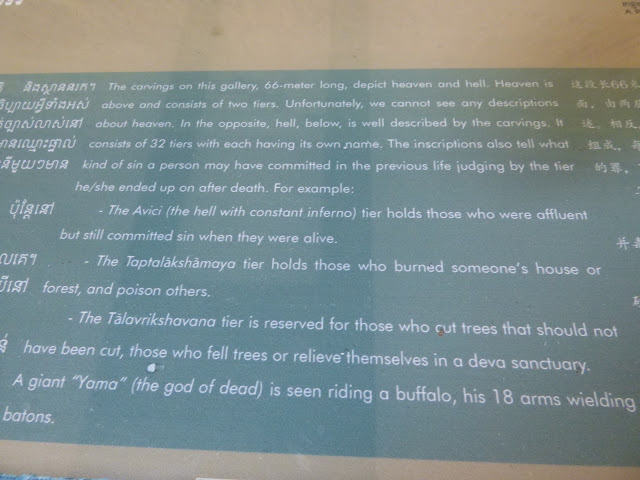
Heaven and Hell To the E of the S gopura, the theme is the judgement of souls and their consignment to heaven or hell. 66m long
There are two registers, with two processions, among them the great and good of Khmer society, carried on thrones and palanquins. They are confidently on their way to Heaven.
Almost immediately, both levels rise to make room for "the way down to the realms of hell" at the bottom, where demons waste no time in beating the damned and dragging them towards their just punishments. See how emaciated the sinners are; after 20m they are menaced by Yama's dogs - the hounds of hell - and beyond that they are savaged by wild animals, including a tiger and a beautifully observed Javan rhinoceros. Some of the damned are pulled along like cattle, with a cord through their nostrils.
GREAT SOULS CARRIED TO HEAVEN
YAMA , GOD OF HELL
The central register, after some 18m, shows the place where souls are judged by Yama, the God of Judgement and of the Underworld, 18-armed and riding his traditional mount, a buffalo. His two assessors Dharma and Chitragupta, 3m further on, listen without mercy to the pleas of sinners, who are thrown down into Hell through a trapdoor.
There are sin-specific Hells - 32 of them. In the 3rd Hell, Vaitarani, demons use long pincers to pull out the tongues of their victims (5m after the trapdoor); in the 6th, Nirucchvasa, the damned are slowly cooked; the 9th has the burning lake, Taptalaksamaya; bone-smashing in the 10th, Ashthibhanga. In the next, Krakaccheda, gluttons are sawn in two!!
CHURNING OF THE SEA OF MILK / Cosmic Ocean
Taken from the Bhagavata-Purana, this great Hindu creation myth is here spectacularly realised in one continuous 49m panel.
By pulling alternately on the body of the giant naga Vasuki, which is coiled around Mount Mandara, the gods and asuras rotate the mountain for 1,000 years to churn the cosmic sea - the Sea of Milk - and so produce amrita, the elixir of immortality.
this cooperation between gods and asuras is shattered as soon as the amrita begins to be produced. The gods go back on their promise to give half to the asuras, who then try to steal it. The scene shown here is the actual churning.
For the first 5m, the army of asuras is lined up with horses and elephants; the churning begins directly after this, and the first you see is a giant multi-headed asura - Ravana - holding the five heads of the giant naga Vasuki. Beyond him stretches the team of 92 asuras pulling in unison on the serpent's body.
The cosmic sea is represented by a swirling mass of marine life, caught up in the turbulence, all enclosed by a second representation of the naga, lying flat on the bottom of the ocean, its heads rearing up at the far left. In the sky above fly large numbers of apsaras, created as part of the process.
Marine life getting churned up
In the middle, on the pillar-like Mount Mandara, four-armed Vishnu directs operations. He also appears below, as his turtle avatar Kurma, supporting the rotating mountain as it threatens to sink below the sea.
above, a flying Indra helps to steady the top of the mountain, while close to Vishnu's discus are tiny images of the elephant Airavata and the horse Ucchaissravas, both created by the churning, like the apsaras.
The presence of Ravana and Hanuman on either side is quite unique and not part of the original legend. It represents the Khmer combining the ancient Vedic legend with characters from the Ramayana.Took 1/2 hour break as we were exhausted/dehydrated in the humidity
The Victory of Krishna over the Asuras
the next 52m of bas-relief show Vishnu fighting an army of asuras. Both the design and carving are markedly interior to the preceding bas-reliefs. It was carved much later, between 1546 and 1564
The Victory of Krishna over the Asura Bana
God Vishnu on bird Garuda
Agni, God of Fire on rhinoceros
Multiarmed Banasura on lion chariot
Below, hermits pray in grottoes in Mount Kailasa, the abode of Lord ShivaKrishna kneels before Shiva at Mount Kailasa and agrees to spare Bana's life. Shiva's son Ganesha is seated at his feet.
The Battle between the Asuras and the Devas
This next bas-relief, well carved and running for 94m, shows an unspecified battle between gods and asuras.
it details the 21 important gods in the
Hindu pantheon, with their vahana, or mounts. They
include:
Kubera, God of Wealth, on a Yaksha (27m from
the start)
Agni, God of Fire, in a chariot pulled by
a rhinoceros (33m)
Skanda, God of War, on a peacock
(37m)
Indra, King of the Gods, on the elephant
Airavata (44m)
Vishnu on Garuda (54m)
Yama,
Judge and King of the Dead, on a chariot pulled by buffalos (63
m)
Shiva in a chariot pulled by two bulls Nandi (67m)
Brahma on a hamsa (71m)
Surya, the Sun God, in a
chariot pulled by horses (76m)
Varuna, God of the Ocean, on a 5-headed naga (86m)
The multi-headed asura Kalanemi appears 60m from the start, in a horse-drawn chariot.
Multiheaded Kalanemi
Vishnu on Garuda

BATTLE OF LANKA
the climax of the Ramayana is the Battle of Lanka, in which Rama and his allies, including the monkey troops, defeat Ravana and rescue Sita. The standard of carving is excellent
Vanara sena...monkey troopsThe main characters are near the centre of the 51m panel. 21m from the start, Rama wields his bow while standing on the shoulders of Hanuman. Next to Hanuman stand the demon Vibhisana (Ravana's brother, with whom Rama has forged an alliance) and Rama's brother Lakshmana.
20-armed Ravana on a chariot drawn by monstrous lions

BATTLE AT KURUKSHETRA
Mahabharata, describes the struggle between the Pandavas and the Kauravas, two rival clans who, in the climax, fight the Battle of Kurukshetra in northern India. This 49m section of the W Gallery relates the battle, with the Kauravas advancing from the left and the Pandavas from the right.
The Historic Parade
In contrast to Angkor Wat's other bas-reliefs, this 94m-long military procession has an historical basis, and shows King Suryavarman II, the temple's builder, and his army. It begins, at the W edge, with two registers: in the upper is a royal audience
on the upper register, is the king, seated (in keeping with his rank, larger than any other figure). Below, princesses and ladies of the court are carried in palanquins. On the other side of the king are his ministers and army commanders, and after the audience they rise and leave, descending steps to rejoin the army. From here to the end, the army marches in a single register, its 20 commanders riding war elephants, their rank identified by the number of parasols and name identified in small inscriptions.
The naturalistic depiction of trees and animals in the background of this panel is unusual.
At 12:50 we were out. As we were reaching the entrance we realized we had missed the primary deity Vishnu and the rebel apsara . We should have seen them as we entered
Primary Original Deity Vishnu
REBEL APSARA SMILING SHOWING HER TEETH [forbidden for girls those days]
It was 2 PM when we arrived at the gate. Basically retracing to see Vishnu had ate into an hour. No regrets. Only wish I could have been more focussed when entering.
He had earlier called as to see whether we are OK after some three/ 4 hours. We told him we are enjoying and will take a little more time to come. He was just checking in on us. So he thought we were ready to go home but we were made of sterner stuff .
In Angkor Wat area, walking from one place to another is over open grounds with not an iota of shade and it is pretty difficult . In my research I had decided on following the route suggested by Grand Circuit . After Angkor Wat it would have been logical to go to Ankur Thom and Bayon. But it would be out in the heat once again . Told our driver to take us to a place which has some trees and shade. So he took us to Ta prohm. Great choice. It was stunning, we LOVED it
The map below shows the orientation of important temples.
This is the route shown by the white road
Ta Prohm temple
Mortarless construction... large blocks balanced together
Eerie Beauty of Trees intertwined with the ruins
The way the trees and their roots have enveloped the ruins creates an eerie beauty, nature is reclaiming the stone structuresBanteay Kdei
Face Tower
tree intertwined with the ruin








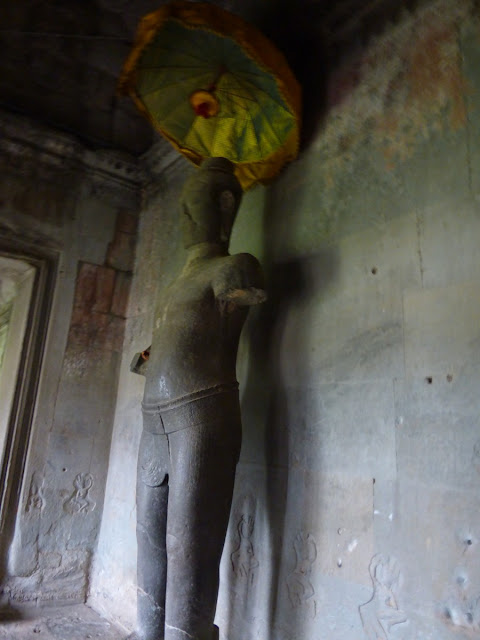
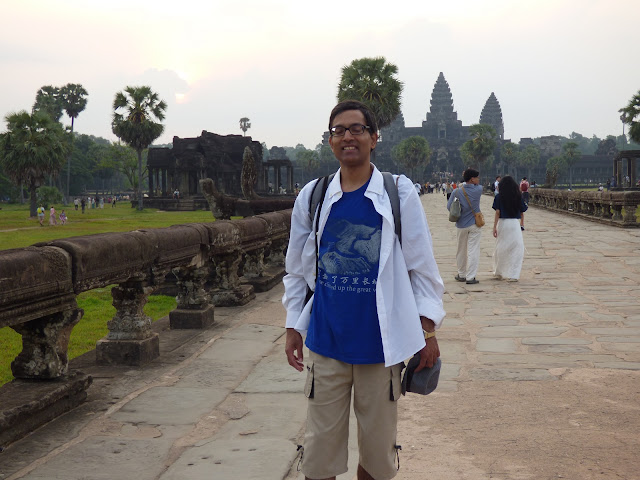













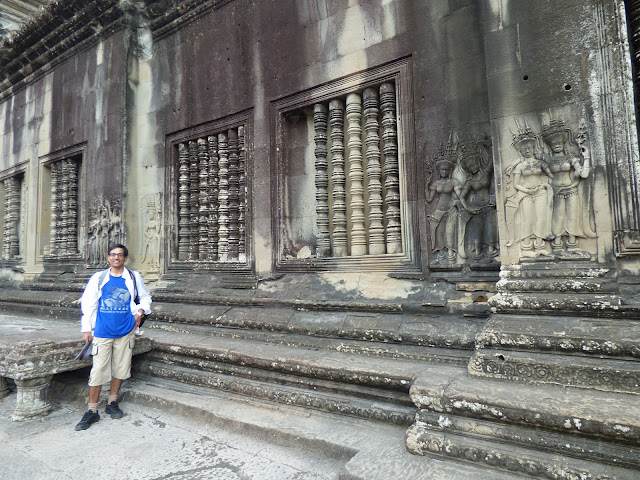







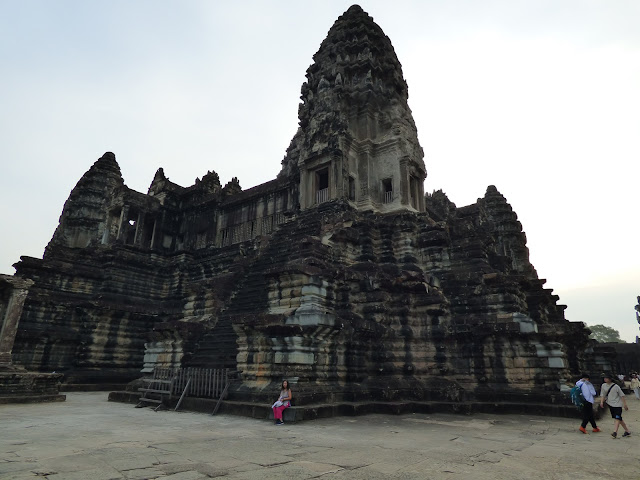


























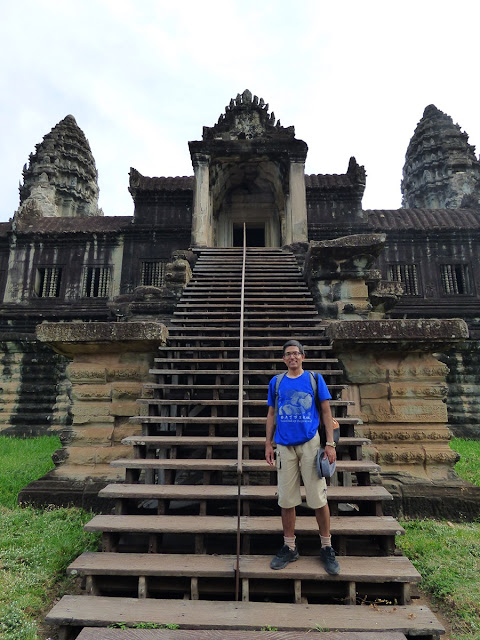




































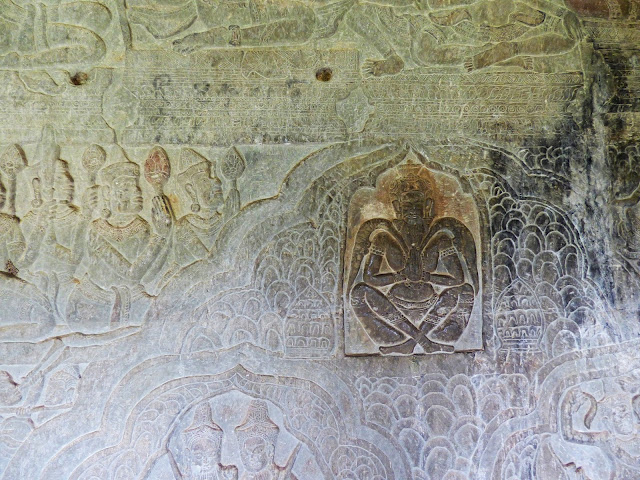

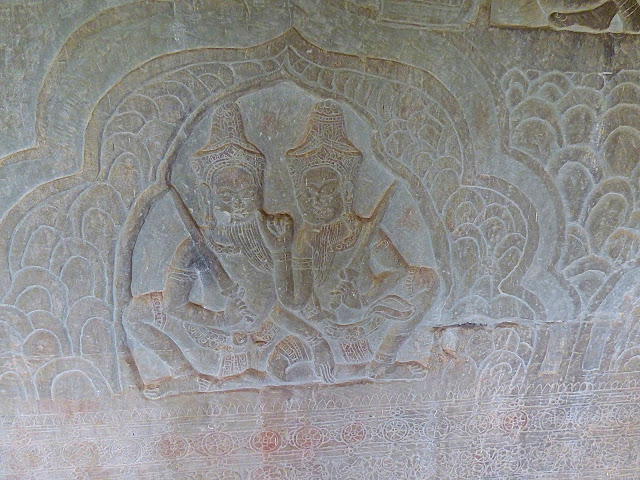









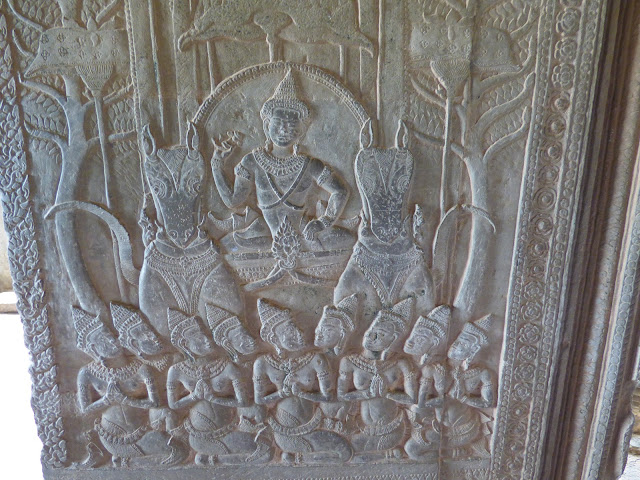







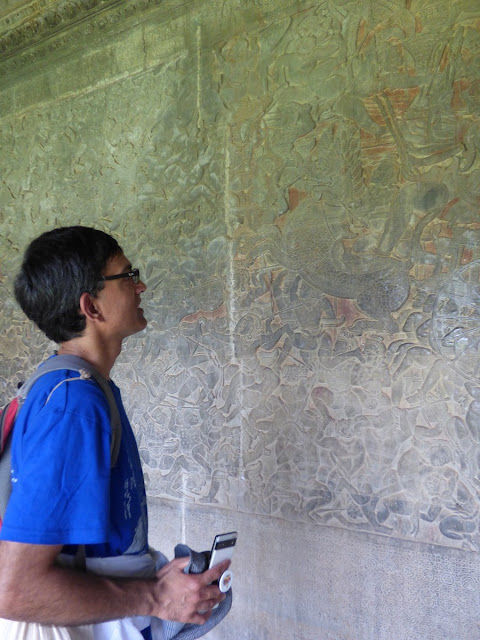


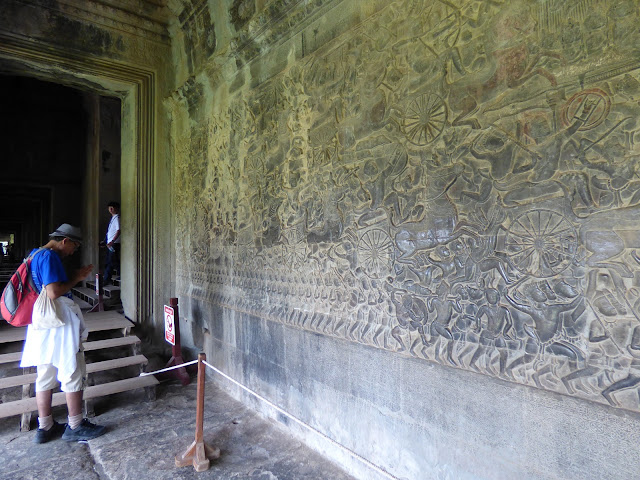
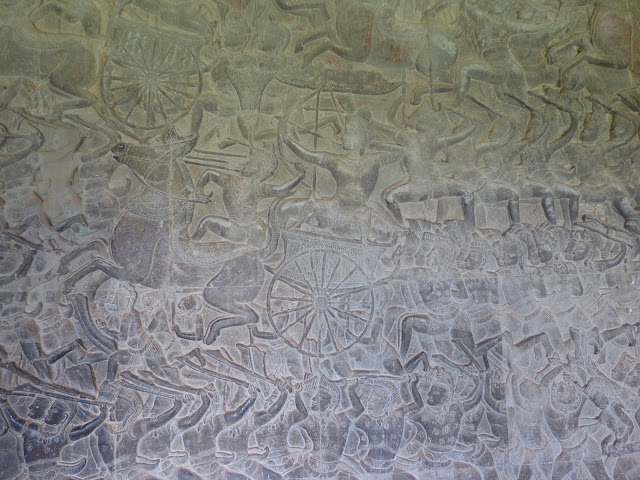
























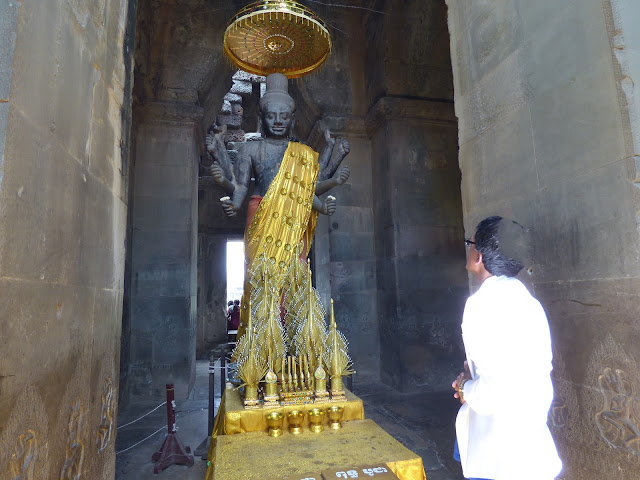
























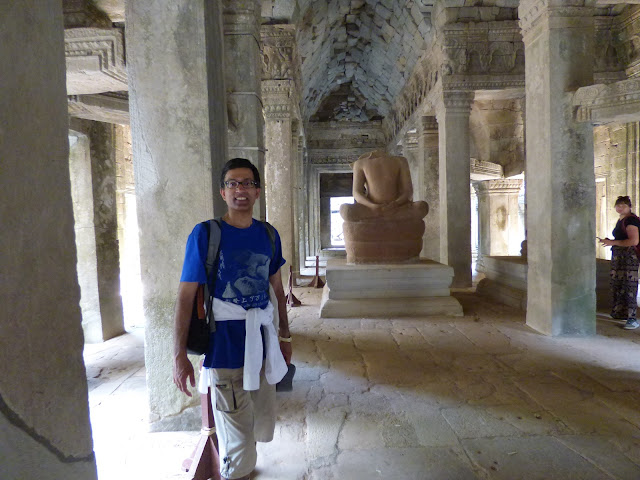


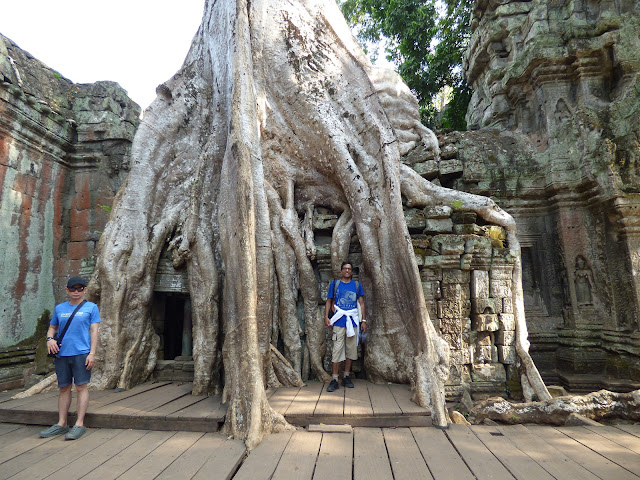
































No comments:
Post a Comment